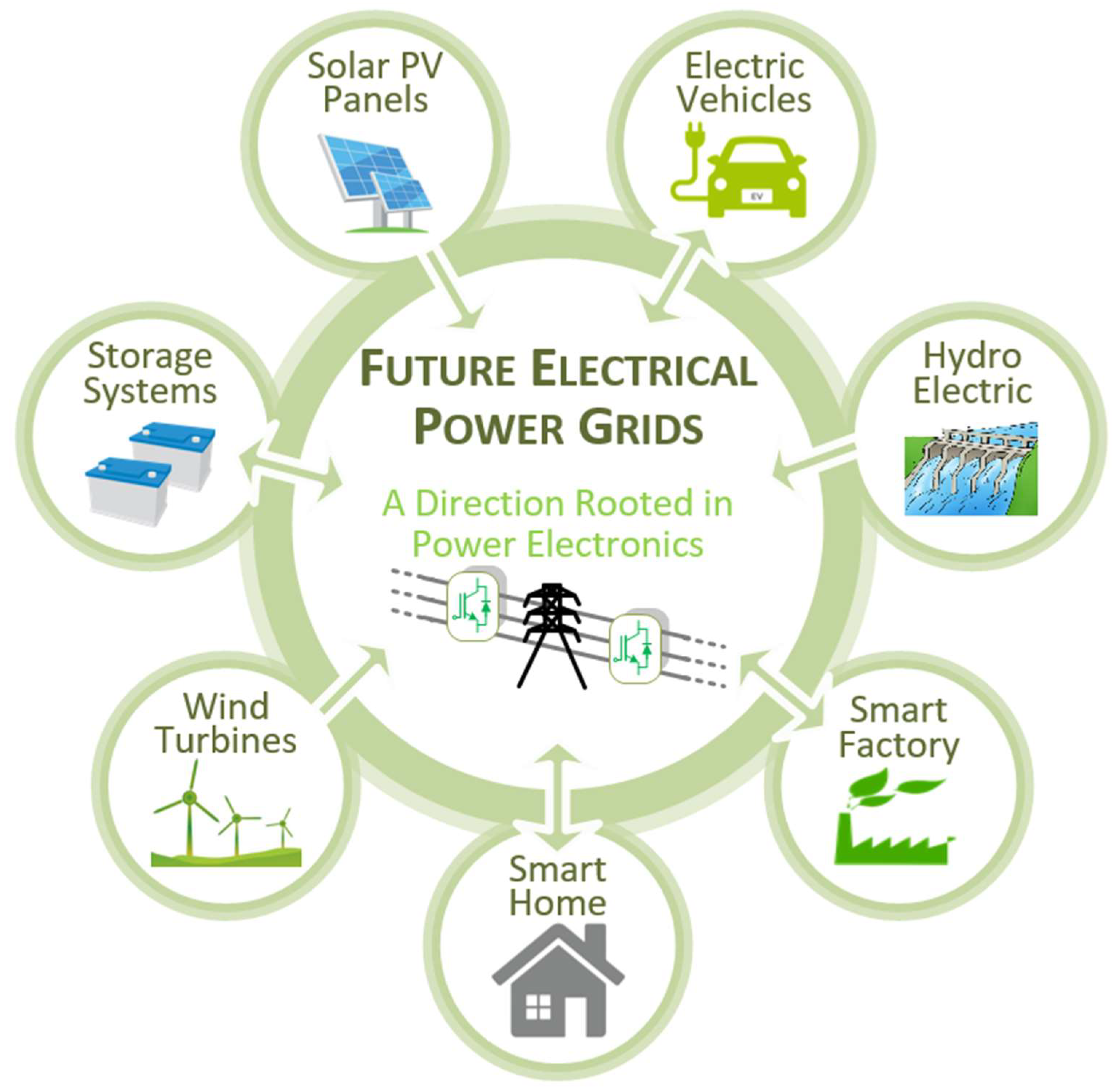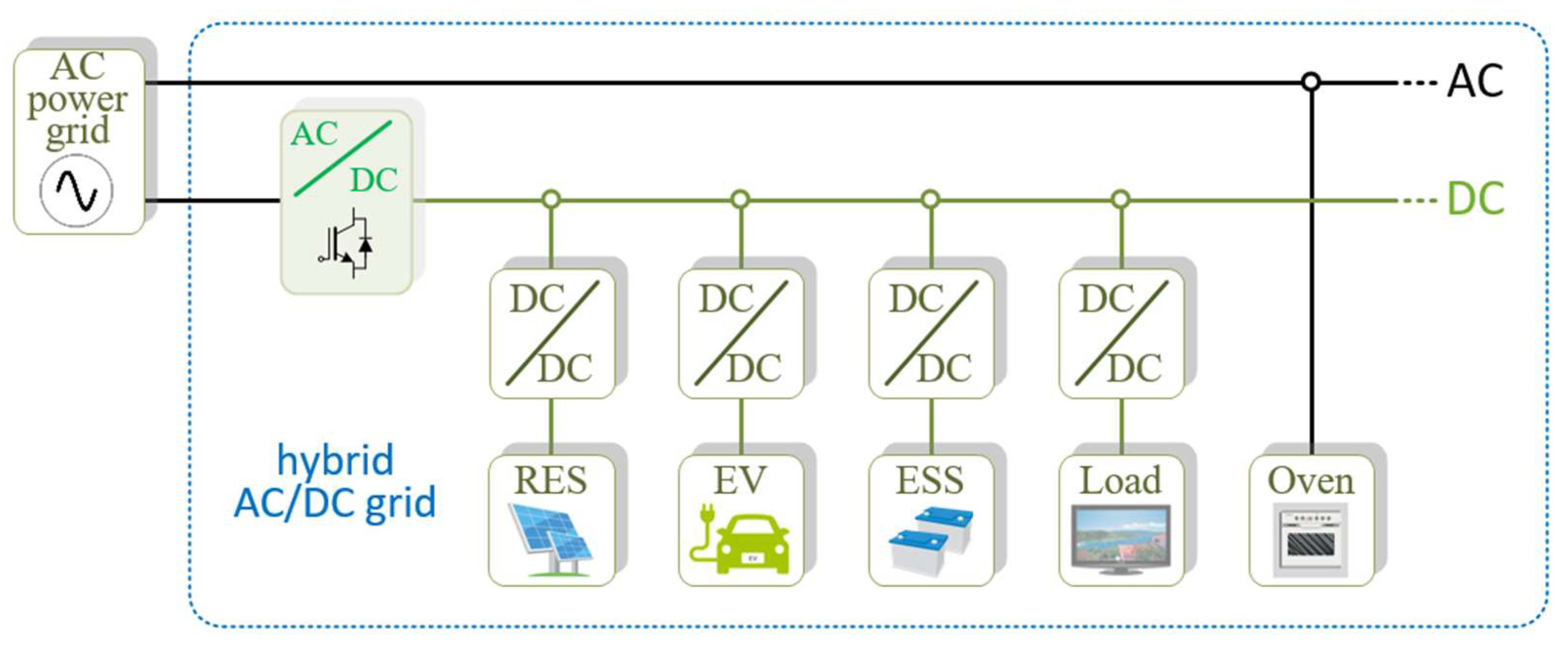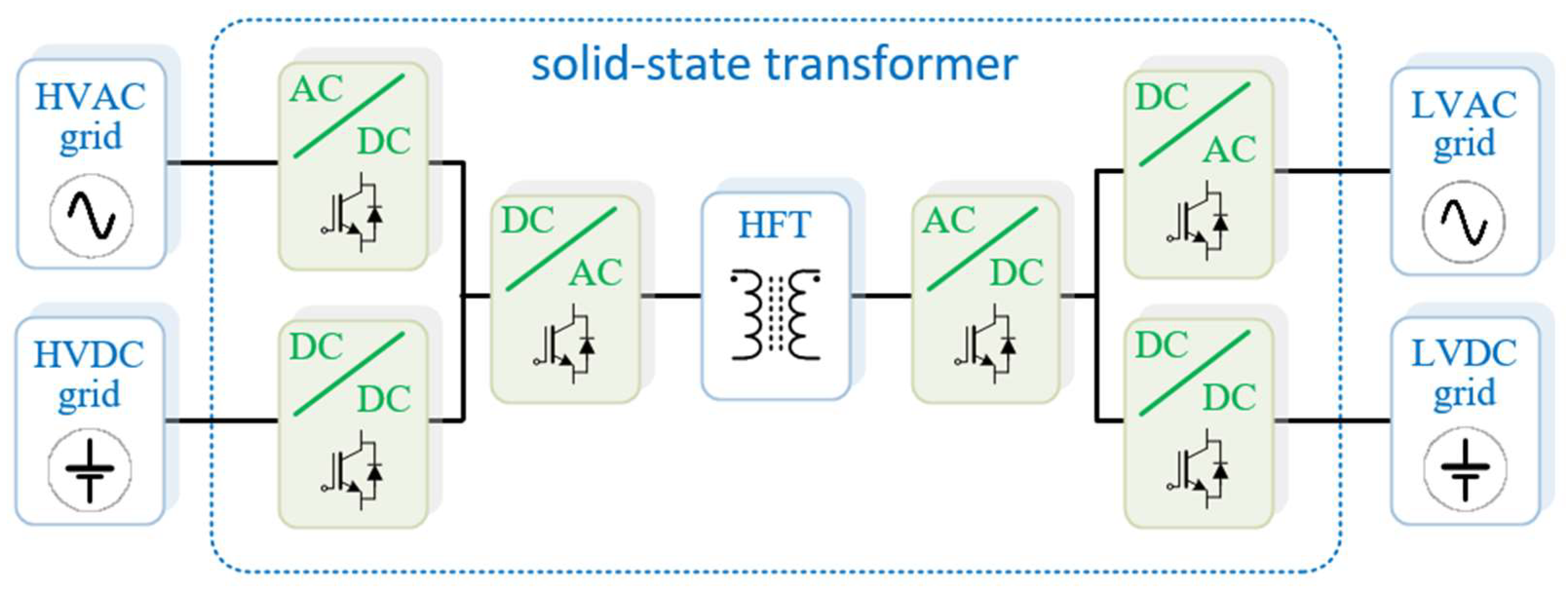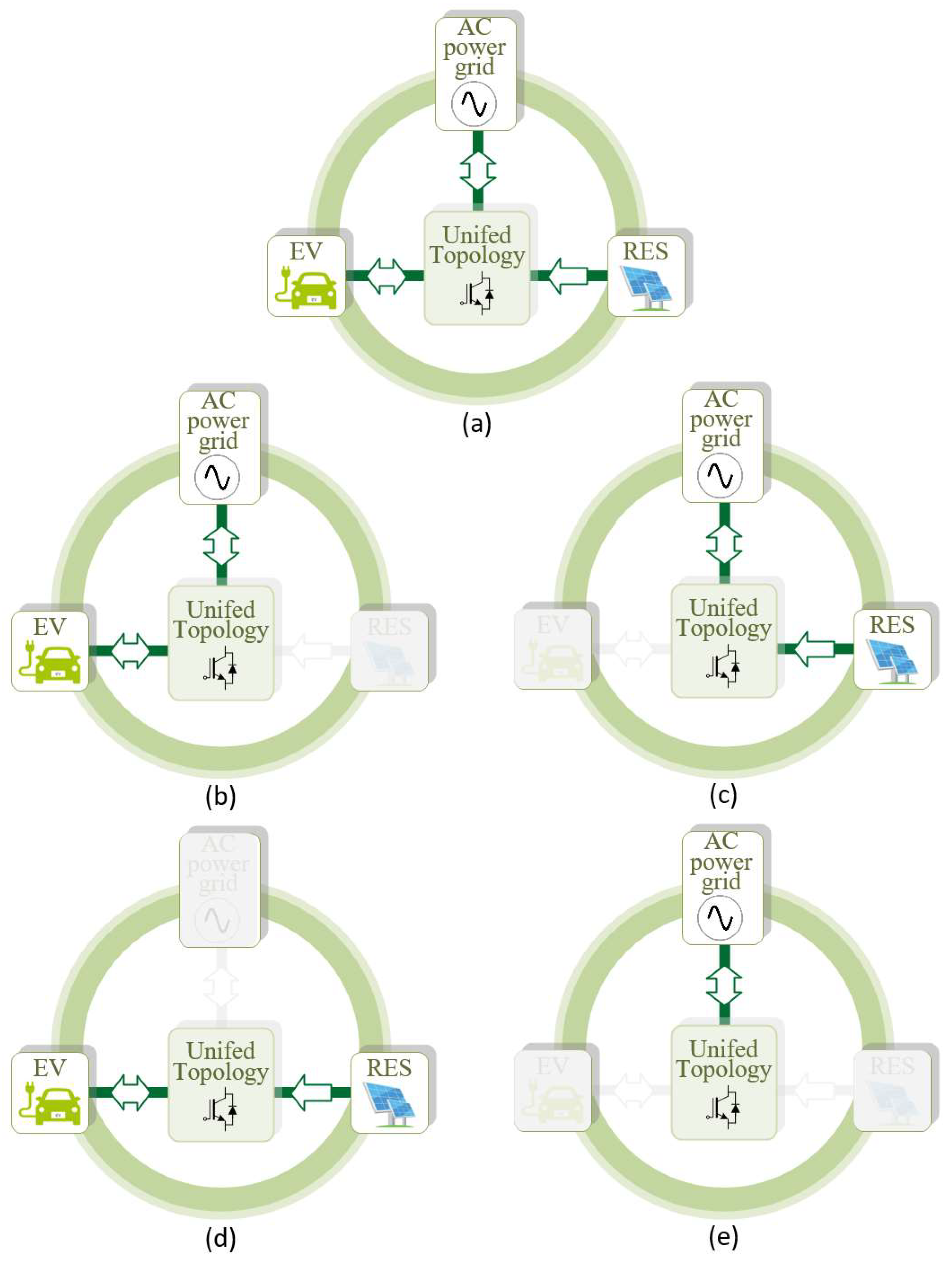The Future of Electrical Power Grids: A Direction Rooted in Power Electronics
Abstract
1. Electrical Power Grids
2. Hybrid AC/DC Power Grids
3. Solid-State Transformer
4. Unified Power Electronics Systems with Multiple Operations
5. Conclusions
Author Contributions
Funding
Data Availability Statement
Acknowledgments
Conflicts of Interest
References
- Li, J.; Chen, W.; Chen, Y.; Sheng, K.; Du, S.; Zhang, Y.; Wu, Y. A Survey on Investment Demand Assessment Models for Power Grid Infrastructure. IEEE Access 2021, 9, 9048–9054. [Google Scholar] [CrossRef]
- Salkuti, S.R. Emerging and Advanced Green Energy Technologies for Sustainable and Resilient Future Grid. Energies 2022, 15, 6667. [Google Scholar] [CrossRef]
- Srivastava, I.; Bhat, S.; Vardhan, B.V.S.; Bokde, N.D. Fault Detection, Isolation and Service Restoration in Modern Power Distribution Systems: A Review. Energies 2022, 15, 7264. [Google Scholar] [CrossRef]
- Hussain, S.; El-Bayeh, C.Z.; Lai, C.; Eicker, U. Multi-Level Energy Management Systems Toward a Smarter Grid: A Review. IEEE Access 2021, 9, 71994–72016. [Google Scholar] [CrossRef]
- Zhang, T.; Yan, X.; Zhang, R.; Ye, Q.; Ma, J. Distributed Architecture of Power Grid Asset Management and Future Research Directions. IEEE Access 2022, 10, 57588–57595. [Google Scholar] [CrossRef]
- Mololoth, V.K.; Saguna, S.; Åhlund, C. Blockchain and Machine Learning for Future Smart Grids: A Review. Energies 2023, 16, 528. [Google Scholar] [CrossRef]
- Malla, T.B.; Bhattarai, A.; Parajuli, A.; Shrestha, A.; Chhetri, B.B.; Chapagain, K. Status, Challenges and Future Directions of Blockchain Technology in Power System: A State of Art Review. Energies 2022, 15, 8571. [Google Scholar] [CrossRef]
- Massaoudi, M.; Abu-Rub, H.; Refaat, S.S.; Chihi, I.; Oueslati, F.S. Deep Learning in Smart Grid Technology: A Review of Recent Advancements and Future Prospects. IEEE Access 2021, 9, 54558–54578. [Google Scholar] [CrossRef]
- Weinand, J.M.; Ried, S.; Kleinebrahm, M.; McKenna, R.; Fichtner, W. Identification of Potential Off-Grid Municipalities with 100% Renewable Energy Supply for Future Design of Power Grids. IEEE Trans. Power Syst. 2022, 37, 3321–3330. [Google Scholar] [CrossRef]
- Jiang, J.; Peyghami, S.; Coates, C.; Blaabjerg, F. A Decentralized Reliability-Enhanced Power Sharing Strategy for PV-Based Microgrids. IEEE Trans. Power Electron. 2020, 36, 7281–7293. [Google Scholar] [CrossRef]
- Rosso, R.; Wang, X.; Liserre, M.; Lu, X.; Engelken, S. Grid-Forming Converters: Control Approaches, Grid-Synchronization, and Future Trends—A Review. IEEE Open J. Ind. Appl. 2021, 2, 93–109. [Google Scholar] [CrossRef]
- Ma, K.; Wang, J.; Cai, X.; Blaabjerg, F. AC Grid Emulations for Advanced Testing of Grid-Connected Converters—An Overview. IEEE Trans. Power Electron. 2021, 36, 1626–1645. [Google Scholar] [CrossRef]
- Tang, Z.; Yang, Y.; Blaabjerg, F. Power electronics: The enabling technology for renewable energy integration. CSEE J. Power Energy Syst. 2022, 8, 39–52. [Google Scholar]
- Ali, S.W.; Sadiq, M.; Terriche, Y.; Naqvi, S.A.R.; Hoang, L.Q.N.; Mutarraf, M.U.; Hassan, M.A.; Yang, G.; Su, C.-L.; Guerrero, J.M. Offshore Wind Farm-Grid Integration: A Review on Infrastructure, Challenges, and Grid Solutions. IEEE Access 2021, 9, 102811–102827. [Google Scholar] [CrossRef]
- Zhang, H.; Xiang, W.; Lin, W.; Wen, J. Grid Forming Converters in Renewable Energy Sources Dominated Power Grid: Control Strategy, Stability, Application, and Challenges. J. Mod. Power Syst. Clean Energy 2021, 9, 1239–1256. [Google Scholar] [CrossRef]
- Liu, H.; Bi, T.; Xu, S.; Li, J.; Lin, J.; Zhao, Z.; Yang, F.; Ding, H.; Shang, J.; Liu, S. A Full-View Synchronized Measurement System for the Renewables, Controls, Loads, and Waveforms of Power-Electronics-Enabled Power Distribution Grids. IEEE Trans. Smart Grid 2022, 13, 3879–3890. [Google Scholar] [CrossRef]
- Monteiro, V.; Lima, P.; Sousa, T.J.C.; Martins, J.S.; Afonso, J.L. An Off-Board Multi-Functional Electric Vehicle Charging Station for Smart Homes: Analysis and Experimental Validation. Energies 2020, 13, 1864. [Google Scholar] [CrossRef]
- Petrichenko, L.; Sauhats, A.; Diahovchenko, I.; Segeda, I. Economic Viability of Energy Communities versus Distributed Prosumers. Sustainability 2022, 14, 4634. [Google Scholar] [CrossRef]
- Reno, M.J.; Brahma, S.; Bidram, A.; Ropp, M.E. Influence of Inverter-Based Resources on Microgrid Protection: Part 1: Microgrids in Radial Distribution Systems. IEEE Power Energy Mag. 2021, 19, 36–46. [Google Scholar] [CrossRef]
- Reno, M.J.; Brahma, S.; Bidram, A.; Ropp, M.E. Influence of Inverter-Based Resources on Microgrid Protection: Part 2: Secondary Networks and Microgrid Protection. IEEE Power Energy Mag. 2021, 19, 47–57. [Google Scholar] [CrossRef]
- Jasim, A.M.; Jasim, B.H.; Neagu, B.-C.; Alhasnawi, B.N. Coordination Control of a Hybrid AC/DC Smart Microgrid with Online Fault Detection, Diagnostics, and Localization Using Artificial Neural Networks. Electronics 2023, 12, 187. [Google Scholar] [CrossRef]
- Ansari, S.; Chandel, A.; Tariq, M. A Comprehensive Review on Power Converters Control and Control Strategies of AC/DC Microgrid. IEEE Access 2020, 9, 17998–18015. [Google Scholar] [CrossRef]
- Litwin, M.; Zieliński, D.; Gopakumar, K. Remote Micro-Grid Synchronization Without Measurements at the Point of Common Coupling. IEEE Access 2020, 8, 212753–212764. [Google Scholar] [CrossRef]
- Zhang, M.; Sun, L. PLL and Additional Frequency Control Constituting an Adaptive Synchronization Mechanism for VSCs. IEEE Trans. Power Syst. 2020, 35, 4920–4923. [Google Scholar] [CrossRef]
- Li, M.; Wei, B.; Matas, J.; Guerrero, J.M.; Vasquez, J.C. Advanced synchronization control for inverters parallel operation in microgrids using coupled Hopf oscillators. CPSS Trans. Power Electron. Appl. 2020, 5, 224–234. [Google Scholar] [CrossRef]
- Gonçalves, J.T.; Valtchev, S.; Melicio, R.; Gonçalves, A.; Blaabjerg, F. Hybrid Three-Phase Rectifiers with Active Power Factor Correction: A Systematic Review. Electronics 2021, 10, 1520. [Google Scholar] [CrossRef]
- Khan, Z.W.; Minxiao, H.; Kai, C.; Yang, L.; Rehman, A.U. State of the Art DC-DC Converter Topologies for the Multi-Terminal DC Grid Applications: A Review. In Proceedings of the 2020 IEEE International Conference on Power Electronics, Smart Grid and Renewable Energy, Kochi, India, 2–4 January 2020; pp. 1–7. [Google Scholar]
- Monteiro, V.; Monteiro, L.F.C.; Franco, F.L.; Mandrioli, R.; Ricco, M.; Grandi, G.; Afonso, J.L. The Role of Front-End AC/DC Converters in Hybrid AC/DC Smart Homes: Analysis and Experimental Validation. Electronics 2021, 10, 2601. [Google Scholar] [CrossRef]
- Rivera, S.; Lizana, R.; Kouro, S.; Dragičević, T.; Wu, B. Bipolar DC Power Conversion: State-of-the-Art and Emerging Technologies. IEEE J. Emerg. Sel. Top. Power Electron. 2020, 9, 1192–1204. [Google Scholar] [CrossRef]
- Zhu, R.; Andresen, M.; Langwasser, M.; Liserre, M.; Lopes, J.P.; Moreira, C.; Rodrigues, J.; Couto, M. Smart transformer/large flexible transformer. China Electrotech. Soc. Trans. Electr. Mach. Syst. 2020, 4, 264–274. [Google Scholar] [CrossRef]
- Das, D.; Hrishikesan, V.M.; Kumar, C.; Liserre, M. Smart Transformer-Enabled Meshed Hybrid Distribution Grid. IEEE Trans. Ind. Electron. 2020, 68, 282–292. [Google Scholar] [CrossRef]
- Yao, J.; Chen, W.; Xue, C.; Yuan, Y.; Wang, T. An ISOP Hybrid DC Transformer Combining Multiple SRCs and DAB Converters to Interconnect MVDC and LVDC Distribution Networks. IEEE Trans. Power Electron. 2020, 35, 11442–11452. [Google Scholar] [CrossRef]
- Zheng, G.; Chen, Y.; Kang, Y. Modeling and control of the modular multilevel converter (MMC) based solid state transformer (SST) with magnetic integration. China Electrotech. Soc. Trans. Electr. Mach. Syst. 2020, 4, 309–318. [Google Scholar] [CrossRef]
- Liu, T.; Yang, X.; Chen, W.; Xuan, Y.; Li, Y.; Huang, L.; Hao, X. High-Efficiency Control Strategy for 10-kV/1-MW Solid-State Transformer in PV Application. IEEE Trans. Power Electron. 2020, 35, 11770–11782. [Google Scholar] [CrossRef]
- Pool-Mazun, E.I.; Sandoval, J.J.; Enjeti, P.; Pitel, I.J. An Integrated Solid State Transformer (I-SST) with High-Frequency Isolation for EV Fast-Charging Applications. IEEE J. Emerg. Sel. Top. Ind. Electron. 2020, 1, 46–56. [Google Scholar] [CrossRef]
- Rahman, M.A.; Islam, M.R.; Muttaqi, K.M.; Sutanto, D. Modeling and Control of SiC-Based High-Frequency Magnetic Linked Converter for Next Generation Solid State Transformers. IEEE Trans. Energy Convers. 2020, 35, 549–559. [Google Scholar] [CrossRef]
- Zheng, L.; Kandula, R.P.; Divan, D. Soft-Switching Solid-State Transformer with Reduced Conduction Loss. IEEE Trans. Power Electron. 2020, 36, 5236–5249. [Google Scholar] [CrossRef]
- Sun, X.; Wang, H.; Qi, L.; Liu, F. Research on Single-Stage High-Frequency-Link SST Topology and Its Optimization Control. IEEE Trans. Power Electron. 2020, 35, 8701–8711. [Google Scholar] [CrossRef]
- Liu, Y.; Liu, Y.; Ge, B.; Abu-Rub, H. Interactive Grid Interfacing System by Matrix-Converter-Based Solid State Transformer with Model Predictive Control. IEEE Trans. Ind. Inform. 2020, 16, 2533–2541. [Google Scholar] [CrossRef]
- Mishra, D.; Ghadi, M.; Li, L.; Hossain, M.; Zhang, J.; Ray, P.; Mohanty, A. A review on solid-state transformer: A breakthrough technology for future smart distribution grids. Int. J. Electr. Power Energy Syst. 2021, 133, 107255. [Google Scholar] [CrossRef]
- Monteiro, V.; Martins, J.; Fernandes, A.; Afonso, J. Review of a Disruptive Vision of Future Power Grids: A New Path Based on Hybrid AC/DC Grids and Solid-State Transformers. Sustainability 2021, 13, 9423. [Google Scholar] [CrossRef]
- Martin, S.; Dong, X.; Li, H. Model Development and Predictive Control of a Low-Inertia DC Solid-State Transformer (SST). IEEE J. Emerg. Sel. Top. Power Electron. 2022, 10, 6482–6494. [Google Scholar] [CrossRef]
- Miura, Y.; Higuchi, J. Virtual Synchronous Machine Control Applied to Solid State Transformer. In Proceedings of the IEEE Energy Conversion Congress and Exposition (ECCE), Detroit, MI, USA, 9–13 October 2022; pp. 1–8. [Google Scholar]
- Khodabakhsh, J.; Moschopoulos, G. Primary Frequency Control in Islanded Microgrids Using Solid-State Transformers as Virtual Synchronous Machines. In Proceedings of the IEEE Energy Conversion Congress and Exposition (ECCE), Detroit, MI, USA, 11–15 October 2020; pp. 5380–5385. [Google Scholar]
- Kwon, M.; Park, S.; Oh, C.-Y.; Lee, J.; Choi, S. Unified Control Scheme of Grid-Connected Inverters for Autonomous and Smooth Transfer to Stand-Alone Mode. IEEE Trans. Power Electron. 2022, 37, 416–425. [Google Scholar] [CrossRef]
- Wang, B.; Dehghanian, P.; Zhao, D. Chance-Constrained Energy Management System for Power Grids With High Proliferation of Renewables and Electric Vehicles. IEEE Trans. Smart Grid 2020, 11, 2324–2336. [Google Scholar] [CrossRef]
- Gamboa, G.; Hamilton, C.; Kerley, R.; Elmes, S.; Arias, A.; Shen, J.; Batarseh, I. Control Strategy of a Multi-Port, Grid Connected, Direct-DC PV Charging Station for Plug-in Electric Vehicles. In Proceedings of the IEEE Energy Conversion Congress and Exposition, Atlanta, GA, USA, 12–16 September 2010; pp. 1173–1177. [Google Scholar]
- Caines, A.; Ghosh, A.; Bhattacharjee, A.; Feldman, A. The Grid Independence of an Electric Vehicle Charging Station with Solar and Storage. Electronics 2021, 10, 2940. [Google Scholar] [CrossRef]
- Verma, A.; Singh, B. AFF-SOGI-DRC Control of Renewable Energy Based Grid Interactive Charging Station for EV with Power Quality Improvement. IEEE Trans. Ind. Appl. 2021, 57, 588–597. [Google Scholar] [CrossRef]
- Verma, A.; Singh, B.; Chandra, A.; Al-Haddad, K. An Implementation of Solar PV Array Based Multifunctional EV Charger. IEEE Trans. Ind. Appl. 2020, 56, 4166–4178. [Google Scholar] [CrossRef]
- Monteiro, V.; Afonso, J.L. A Unified Topology for the Integration of Electric Vehicle, Renewable Energy Source, and Active Filtering for the Power Quality Improvement of the Electrical Power Grid: An Experimental Validation. Electronics 2022, 11, 429. [Google Scholar] [CrossRef]




Disclaimer/Publisher’s Note: The statements, opinions and data contained in all publications are solely those of the individual author(s) and contributor(s) and not of MDPI and/or the editor(s). MDPI and/or the editor(s) disclaim responsibility for any injury to people or property resulting from any ideas, methods, instructions or products referred to in the content. |
© 2023 by the authors. Licensee MDPI, Basel, Switzerland. This article is an open access article distributed under the terms and conditions of the Creative Commons Attribution (CC BY) license (https://creativecommons.org/licenses/by/4.0/).
Share and Cite
Monteiro, V.; Afonso, J.L. The Future of Electrical Power Grids: A Direction Rooted in Power Electronics. Energies 2023, 16, 4929. https://doi.org/10.3390/en16134929
Monteiro V, Afonso JL. The Future of Electrical Power Grids: A Direction Rooted in Power Electronics. Energies. 2023; 16(13):4929. https://doi.org/10.3390/en16134929
Chicago/Turabian StyleMonteiro, Vitor, and Joao L. Afonso. 2023. "The Future of Electrical Power Grids: A Direction Rooted in Power Electronics" Energies 16, no. 13: 4929. https://doi.org/10.3390/en16134929
APA StyleMonteiro, V., & Afonso, J. L. (2023). The Future of Electrical Power Grids: A Direction Rooted in Power Electronics. Energies, 16(13), 4929. https://doi.org/10.3390/en16134929








